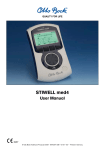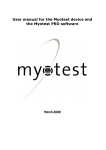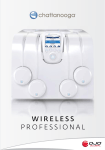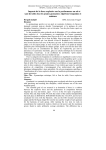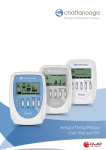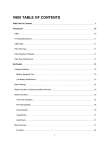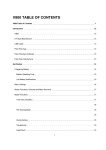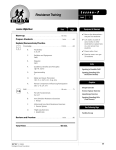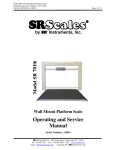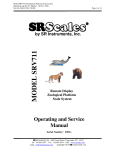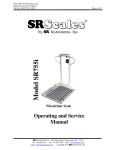Download Quick Start Guide EN
Transcript
Quick Start Guide EN 18.3.2008 11:18 Page 1 C M Y CM MY CY CMY K ENGLISH Composite Quick Start Guide EN 18.3.2008 11:18 Page 2 C Composite M Y CM MY CY CMY K Quick Start Guide EN 18.3.2008 11:18 Page 3 C M Y CM MY CY CMY K TABLE OF CONTENTS Introduction 1 Initial settings of Myotest 3 THE TESTS PERFORMED BY MYOTEST Composite Bench press 7 Half-squat 9 Jump - plyometry 11 Jump - CMJ 13 Jump - SJ 15 Bench press profile 17 Half-squat profile 19 Free “Trainer” test 21 Technical data sheet of Myotest 23 Quick Start Guide EN 18.3.2008 11:18 Page 4 C M Y CM MY CY CMY K "How can I improve my performance?" This is the central question for any sports training, no matter what sport and what the level of the athlete. Myotest provides answers by giving information on muscular capacity such as power, strength and velocity. Parameters for the performance measurements Muscle performance tests Force: The mechanical action necessary for the acceleration of a mass, measured in newtons, In sport, force is a decisive factor in any act of movement, braking or acceleration. Myotest proposes several standardized tests where the quality of execution is defined and monitored by the Myotest itself. It thus becomes easier to reproduce the same movements from one occasion to the next. Please follow the instructions in this manual and on DVD carefully. An open test (coach) allows professionals to perform other measurements in accordance with their specific requirements on machines of their choice. Velocity: The ratio of distance to time is measured in centimeters per second (cm/s) here. The velocity of action of a muscular chain is very important in sports performance. Selection of tests Our Internet site www.myotest.com provides you with information to make the selection of tests for your sport easier. Don't hesitate to contact our fitness coaches for guidance. Power: The work rate or power output measured in watts. This parameter is very often correlated with sporting performance. 1 Composite Quick Start Guide EN 18.3.2008 11:18 Page 5 C M Y CM MY CY CMY K Requirements for achieving optimum results: Quality of execution: The tests must be performed by exactly following the instructions provided for each of the tests and must be executed rigorously. Familiarize yourself with each movement by using our aids (website, DVD and manual), rehearse a few times without the Myotest and then perform measurements without saving the results. As soon as you have understood the logic of the beeps and movements, you are ready to take your first tests. Repeat the movement that you are going to test according to the following procedure: 2x 5 repetitions at low intensity (with light weights if the test is with weights) 2x 5 repetitions at medium intensity (with light weights if the test is with weights) 2x 3 repetitions at high intensity (with medium weights if the test is with weights) Take a break of one minute between sets. At the end of the warm up, take a break of 3 minutes, prepare the test, concentrate... the test can start. Warm up: Make sure to have a good warm up, recover for a few minutes and then perform the movements of the test a few times prior to the measurement (see example below). It is recommended to undergo testing under normal conditions of fatigue. The best time is right after warm up. Don't hesitate to consult our website www.myotest.com which will provide guidance on the type of test for your sport and a host of other information that will help you to improve your performance. The fitness coaches are trained to coach you, so don't hesitate to contact them. Example: Carry out a warm up of 5-10 minutes of cycling or jogging at low intensity (120 bpm/ maximum). Do a few sets of trunk stability exercises of 30'' each. The Myotest team wishes you exciting practice sessions! 2 Composite Quick Start Guide EN 18.3.2008 11:18 Page 6 C M Y CM MY CY CMY K 1. The "enter" key: validates the selections and starts the tests (hold down for 6 seconds = reset) 2. The "esc" key: enables you to return to the previous menu The "-" key: for decreasing the values 3. The "on-off" key: switches the Myotest on and off (hold down for 2 seconds) The "+" key: for incrementing the values 4. The " " key: moves the cursor up 5. The "v" key: moves the cursor down Initial configuration of the Myotest Press the on/off key until the logo appears to power up the Myotest. On start-up, the Myotest will display the "settings" menu. Adjust all the parameters, then press "exit" to save them. Once the settings are carried out, the Myotest displays the "users" menu which lets you define user no.1. Set all values with the +/and v/ keys. For the categories, choose from: 1 Amateur if you are taking up weight training again after an interruption 2 Advanced if you are performing 2 to 3 weight training sessions per week 3 Expert if you are an elite athlete accustomed to using weights during practice Once the user is defined, press "exit" to save all. You can define up to 5 users by selecting "new user" (see 4.a) You can modify the parameters of the Myotest at any time by selecting "settings" and "users" in the main menu of the Myotest. 3 Composite Quick Start Guide EN 18.3.2008 11:18 Page 7 C M Y CM MY CY CMY K 1. "Tests" menu 3. "Settings" menu a) Perform a test Prior to performing a test, don't forget to define your parameters (height, body weight, etc.) in the "users" menu and/or activate the correct user (see 4.c). Choose the desired test, modify the parameters of the test (suggested loads, weight, etc.) by using the /v and +/- keys, then press "next". Follow the instructions displayed on the screen. For more details on each test, please refer to the corresponding section in this manual. This menu lets you modify your initial parameters by using the v/ and +/- keys. Validate all by pressing "exit" at the bottom of the menu. Languages: English, French, Spanish, Italian, German or Dutch Format of the date: dd/mm/yy or mm/dd/yy Date: setting of the date Format of the hour: 12h or 24h Hour: setting of the hour Units: cm/kg or in/lb Volume: volume of the beeps emitted by the device: from 1 to 3 2. "Results" menu a) Accessing the results of your tests Select a user, then the test that you would like to look at and press "view". You can store up to a maximum of 230 tests. The cursor at the top of the screen (MEM) shows the amount of memory used. b) Delete a test Select a user, then the test that you would like to delete. Select "delete" and confirm with "yes". c) Delete all the tests of one user Select a user, then select "delete all tests" right at the bottom of the menu and confirm with "yes". 4. "Users" menu a) Create a new user Select "new user", define the parameters and press "exit". b) Modify an existing user profile Select the user whose profile you would like to modify, select "view/modify", then modify the parameters and press "exit" to confirm. c) Activate a user The user activated is identified by a *. To activate another user, select that user and press "activate". 4 Composite Quick Start Guide EN 18.3.2008 11:18 Page 8 C Connecting the Myotest to a computer: Connect your Myotest to a computer with a USB cable. The Myotest is recognized as a USB key which allows you to connect it to any type of computer without special installations. After a few seconds, a window appears (see opposite). You can close this window and log on to the Internet. Recharging the power unit: When connected to a computer, your Myotest recharges itself automatically. Copying the tests to the Internet and comparing my results: Go to the www.myotest.com website and then to "my account". Register and then upload your results by going to "load tests". Click on "upload". The window below will appear. Click on the corresponding file "USER.DTA" and then on "open". Select the tests that you would like to save on your account and then click on "save tests". The tests are listed in the upper window. A tutorial is available on the website. It shows you the complete upload and storage procedures. 5 Composite M Y CM MY CY CMY K Quick Start Guide EN 18.3.2008 11:18 Page 9 C Installation of the Myotest PRO software: (only for the professional kit, works with Windows XP or Vista) Installation from the CD: The installation starts automatically after the insertion of the CD. Should this not be the case, open the CD and double-click on the Myotest PRO program. Follow the normal procedure. Should there be any problems, go to the FAQ section of www.myotest.com. Installation from the site: Go to the www.myotest.com website and the "e-store" for on-line purchasing. The software purchase automatically generates an email with the license no. and a link for download. A demo version can be downloaded under the "Download/Myotest PRO software (demo version)" section. Click on "proceed" and follow the instructions. The license number entry converts the demo version into the full version. 6 Composite M Y CM MY CY CMY K Quick Start Guide EN 18.3.2008 11:18 Page 10 C M Y CM MY CY CMY K 1. BENCH PRESS Objectives of the test: Measurement of the performance progression of the upper limbs (Power - Force - Velocity), mainly of the pectorals and the triceps. Execution: 5 repetitions aiming for maximum velocity. Load Amateur 1 Advanced 2 Expert 3 Female 10 kg / 20 lbs 20 kg / 45 lbs 30 kg / 65 lbs Male 20 kg / 45 lbs 30 kg / 65 lbs 40 kg / 90 lbs Equipment and preparation: • Free barbell or guided barbell. • Warm up (see user instructions p.1). • Familiarize yourself with the movement prior to the test (dry-runs). • Position the Myotest on the barbell: close to the hand Sequence: 1. Start the Myotest by keeping the "ON/OFF" key pressed until the logo appears. 2. Select the "bench press" test and check that the load corresponds to the training level (see table above), otherwise adjust it. 3. Place the Myotest on the barbell and press "ENTER". 4. Position yourself on the bench, raise the barbell and stay still. 5. At the long beep, lower the barbell right to the chest and remain in a static position. 6. At the short beep, drive the barbell up, aiming for maximum velocity by gripping it firmly until full extension of the arms (your chest may lift off the bench) 7. After the thrust, stay in the extended arms position and wait for the long beep before lowering them into the bent position. Then repeat points 5 to 7. After 5 repetitions, the double beep signals the end of the test. 7 Composite Quick Start Guide EN 18.3.2008 11:18 Page 11 C M Y CM MY CY CMY K Errors: Errors in execution are signaled by a deep beep. The Myotest tolerates two errors before automatically stopping the test so as to not invalidate the results. An error message is generated if the following points are not observed: 1. Execute the movements energetically so that the Myotest can clearly detect them: grip the barbell, lower it and thrust. 2. Stay still during the waiting phases between the long and the short beeps. 3. Perform the movements corresponding to the beeps: long=lower, short=thrust. 4. Perform the thrust movement of the barbell without countermovement. 5. Perform a total of 5 repetitions. 6. The Myotest must be in a vertical position. Results: The results are automatically displayed on the screen after the test. They show the average of the three best repetitions (the power output is the reference). The arrows indicate your progression with respect to the average of your last three tests. Your results Power 560 W Force 365 N Velocity 204 cm/s The Power output, in watts, provides information on your ability to generate mechanical energy over time. This most frequently is the value that correlates best with sporting activity. Force, in newtons, provides information on your ability to produce the highest dynamics possible against the system moved during the impulse. Velocity, in cm/s, is the result of your effort: the greater the impulse, the higher the velocity. The results of the tests are stored in the memory of the device; you can thus access them at all times. Log on to www.myotest.com to store your tests and compare your results with those of other sportspeople and elite athletes. Additional test: The "bench press profile" test (p.17) allows the assessment of your muscular profile and the determination of the optimal training load for the bench press. 8 Composite Quick Start Guide EN 18.3.2008 11:18 Page 12 C M Y CM MY CY CMY K 2. HALF-SQUAT Objectives of the test: Measurement of the performance progression of the lower limbs (Power - Force - Velocity) involved in the majority of sports. Execution: 5 repetitions aiming for maximum height. Load Amateur 1 Advanced 2 Expert 3 Female 20 kg / 45 lbs 40 kg / 90 lbs 60 kg / 130 lbs Male 30 kg / 65 lbs 60 kg / 130 lbs 90 kg / 200 lbs Equipment and preparation: • Free barbell or guided barbell. • Warm up (see user instructions p.1). • Familiarize yourself with the movement prior to the test (dry-runs). • Position the Myotest on the barbell: between the hand and the head Sequence: 1. Start the Myotest by keeping the "ON/OFF" key pressed until the logo appears. 2. Select the "half squat" test and check that the load corresponds to the training level (see table above), otherwise adjust it. 3. Place the Myotest on the barbell and press "ENTER". 4. Position yourself, place the barbell on your shoulders and stand still. 5. At the long beep, bend the knees to 90 degrees, stabilize the barbell and stand still. 6. At the short beep, jump up as high as possible without any countermovement while firmly keeping the load on the shoulders. The landing should be as soft and smooth as possible. 7. Return to the standing position, and wait for the next long beep before bending the knees and for the short beep before jumping. After 5 repetitions, the double beep signals the end of the test. 9 Composite Quick Start Guide EN 18.3.2008 11:18 Page 13 C M Y CM MY CY CMY K Errors: Errors in execution are signaled by a deep beep. The Myotest tolerates two errors before automatically stopping the test so as to not invalidate the results. An error message is generated if the following points are not observed: 1. Execute the movements energetically so that the Myotest can clearly detect them: grip the barbell, bend the knees and jump. 2. Stay still in the waiting phases between the long and the short beeps. 3. Perform the movements corresponding to the beeps: long=bend, short=jump. 4. Jump without countermovement. 5. Perform a total of 5 repetitions. 6. The Myotest must be in a vertical position. Results: The results are automatically displayed on the screen after the test. They show the average of the three best repetitions (the power output is taken as the reference). The arrows indicate your progression with respect to the average of your last three tests. Your results Power 560 W Force 365 N Velocity 204 cm/s The Power output, in watts, provides information on your ability to generate mechanical energy over time. This most frequently is the value that correlates best with sports activity. Force, in newtons, provides information on your ability to produce the highest dynamics possible against the system moved during the impulse. Velocity, in cm/s, is the result of your effort: the greater the impulse, the higher the velocity. The test results are stored in the memory of the device; you can thus access them at all times. Log on to www.myotest.com to store your tests and compare your results with those of other sportspeople and elite athletes. Additional test: The "half-squat profile" test (p.19) allows the assessment of your muscular profile and the determination of the optimal training load for the half squat. 10 Composite Quick Start Guide EN 18.3.2008 11:18 Page 14 C M Y CM MY CY CMY K 3. JUMP - PLYOMETRY Objectives of the test: Measurement of the contractile properties of the leg muscles (flexibility, rigidness or stiffness), the reactivity and the intermuscular coordination qualities of the lower limbs. These values provide information on the bounce qualities that influence performance when impulse is applied to the ground. Execution: 5 repetitions aiming for the maximum height and minimum ground contact time. You must definitely be in good muscular condition with the ability to withstand the strains of the test. If you are suffering from knee or back pains, please consult a specialist beforehand. Equipment and preparation: • Shoes with hard soles • Hard ground • Warm up (see user instructions p.1). • Familiarize yourself with the movement prior to the test (dry-runs). • Position the Myotest on the belt: perfectly straight, always on the left. 5x Sequence: 1. Start the Myotest by keeping the "ON/OFF" key pressed until the logo appears. 2. Select the "depth jump" test and check that body weight is correct, otherwise adjust it. 3. Place the Myotest on the belt and press "ENTER". 4. Start in the standing position, hands on your hips, look straight ahead and stand still. 5. At the short beep, perform a takeoff jump, then bounce back up five times as high as possible and with a ground contact time that is as short as possible, while keeping your hands on your waist (jump off the soles of the foot with minimal bending of the knees, like on a trampoline). After 5 bounces, the double-beep signals the end of the test. 11 Composite Quick Start Guide EN 18.3.2008 11:18 Page 15 C M Y CM MY CY CMY K Errors: Errors in execution are signaled by a deep beep. The Myotest tolerates two errors before automatically stopping the test so as to not invalidate the results. An error message is generated if the following points are not observed: 1. Execute the movements energetically so that the Myotest can clearly detect them. 2. Stand still before the starting beep. 3. Ground contact time must be short and clearly below the time of flight. 4. Perform a total of 5 bounces. Results: The results are automatically displayed on the screen after the test. They show the average of the three best repetitions (the height is taken as the reference). The arrows indicate your progression with respect to the average of your last three tests. Your results Height 27.42 cm T. of contact 148 ms Reactivity 3.198 Stiffness 42.35 kN/m The height of the jump and the ground contact time are the two performances investigated during the test. They will provide information on your bounce ability. The higher you are capable of jumping with a short ground contact time, the higher the reactivity index. Muscular rigidity, which is usually called stiffness, is an interesting indicator enabling you to find the ideal muscular tension for bouncing in running events or team sports, for instance. The test results are stored in the memory of the device; you can thus access them at all times. Log on to www.myotest.com to store your tests and compare your results with those of other sportspeople and elite athletes. Note: The sampling rate is 500Hz to ensure higher precision. 12 Composite Quick Start Guide EN 18.3.2008 11:18 Page 16 C M Y CM MY CY CMY K 4. JUMP - CMJ Objectives of the test: Measurement of the height of the jump Execution: 5 repetitions aiming for the maximum height. Sequence: 1. Start the Myotest by keeping the "ON/OFF" key pressed until the logo appears. Equipment and preparation: • Shoes with hard soles 2. Select the "CMJ jump" test and check that • Hard ground body weight is correct, otherwise adjust it. • Warm up (see user instructions p.1). 3. Place the Myotest on the belt and press • Familiarize yourself with the movement prior to the test "ENTER". (dry-runs). 4. Start in the standing position, hands on • Position the Myotest on the belt: perfectly straight, always on the left. your hips, look straight ahead and stand still. 5. At the short beep, make a free lunge movement (bend your knees) and jump as high as possible while keeping your hands 5x on your waist. The landing should be soft and smooth. 6. After landing, return to the standing position and, while standing still, await the next beep before repeating the jump. After 5 repetitions, the double-beep signals the end of the test 13 Composite Quick Start Guide EN 18.3.2008 11:18 Page 17 C M Y CM MY CY CMY K Errors: Errors in execution are signaled by a deep beep. The Myotest tolerates two errors before automatically aborting the test so as to not invalidate the results. An error message is generated if the following points are not observed: 1. Execute the movements energetically so that the Myotest can clearly detect them. 2. Stay still during the waiting phases for the beeps. 3. Respect the rhythm of the beeps and carry out the jump upon their signal. 4. The countermovement (lunge) should be well emphasized. 5. Perform all of the 5 repetitions. Results: The results are automatically displayed on the screen after the test. They show the average of the three best repetitions (the height is taken as the reference). The arrows indicate your progression with respect to the average of your last three tests. Your results Height 39.1 cm Power 62.81 W/kg Force 30.23 N/kg The height is given in centimeters. The power output and force values are taken during the countermovement phase and are given relative to body weight, in watts and newtons per kilogram respectively. This allows the comparison of your performances with those of other users. The velocity is an absolute value given in centimeters per second. Note: the movement is free which means that a change in the bending and straightening path considerably influences the power and force values. We suggest that height is used as the most relevant value if you are not monitored by an expert. Velocity 276 cm/s The test results are stored in the memory of the device; you can thus access them at all times. Log on to www.myotest.com to store your tests and compare your results with those of other sportspeople and elite athletes. 14 Composite Quick Start Guide EN 18.3.2008 11:18 Page 18 C M Y CM MY CY CMY K 5. JUMP - SJ Objectives of the test: Measurement of the statodynamic explosiveness of the legs (without lunge countermovement) Execution: 5 repetitions aiming for maximum height. Sequence: Equipment and preparation: • Shoes with hard soles 1. Start the Myotest by keeping the "ON/OFF" • Hard ground key pressed until the logo appears. • Warm up (see user instructions p.1). 2. Select the "squat jump" test and check that • Familiarize yourself with the movement prior to the test body weight is correct, otherwise adjust it. (dry-runs). 3. Place the Myotest on the belt and press • Position the Myotest on the belt: perfectly straight, always on the left. "ENTER". 4. Start in the standing position, hands on your hips, look straight ahead, bend the knees to 90 degrees and stand still. 5x 5. At the short beep, jump as high as possible without any countermovement lunge while keeping your hands on your waist. The landing should be soft and smooth. 6. After landing, return to the previous position with your knees flexed at 90 degrees and, while standing still, await the next beep before repeating the jump. After 5 repetitions, the double-beep signals the end of the test 15 Composite Quick Start Guide EN 18.3.2008 11:18 Page 19 C M Y CM MY CY CMY K Errors: Errors in execution are signaled by a deep beep. The Myotest tolerates two errors before automatically stopping the test so as to not invalidate the results. An error message is generated if the following points are not observed: 1. Execute the movements energetically so that the Myotest can clearly detect them. 2. Stay still during the waiting phases for the beeps. 3. Respect the rhythm of the beeps and carry out the jump upon their signal. 4. Jump without countermovement (no lunge). 5. Perform all of the 5 repetitions. Results: The results are automatically displayed on the screen after the test. They show the average of the three best repetitions (the height is taken as the reference). The arrows indicate your progression with respect to the average of your last three tests. Your results Height 39.1 cm Power 62.81 W/kg Force 30.23 N/kg Velocity 276 cm/s The reference value is that of the height, given in centimeters. The following values of power output and concentric force are given in relation to body weight, in watts and newtons per kilogram respectively. This allows the comparison of your performances with those of other users. The velocity is an absolute value given in centimeters per second. The test results are stored in the memory of the device; you can thus access them at all times. Log on to www.myotest.com to store your tests and compare your results with those of other sportspeople and elite athletes. 16 Composite Quick Start Guide EN 18.3.2008 11:18 Page 20 C M Y CM MY CY CMY K 6. BENCH PRESS PROFILE Objectives of the test: Determination of the optimal training loads for the upper limb muscles (pectorals and triceps). Execution: 8 sets of one repetition while increasing the load per stage. Equipment and preparation: • Guided barbell or free barbell. • Warm up (see user instructions p.1). • Familiarize yourself with the movement prior to the test (dry-runs). • Position the Myotest on the barbell: close to the hand Load Female Male First set 20 kg / 45 lbs 20 kg / 45 lbs Following set According ind. by the Myotest Note: total weight including the barbell. Sequence: 1. Start the Myotest by keeping the "ON/OFF" key pressed until the logo appears. 2. Select the "bench press profile" test 3. Load the barbell in order to achieve a total weight of 20kg / 45 lbs including the barbell 4. Place the Myotest on the barbell and press "ENTER". 5. Position yourself on the bench, lift the barbell and stay still. 6. At the long beep, lower the barbell right to the chest and remain in a static position. 7. At the short beep, drive the barbell up aiming for maximum velocity by gripping it firmly until the arms are fully extended (the chest may lift off the bench). 8. After the thrust, remain with your arms extended. A double beep indicates the end of the set, then place the barbell on its rack. 9. Check the Myotest screen and load the barbell to achieve the total weight indicated while the Myotest counts down a break of one and a half minutes. 10. A beep signals the end of the break, press "NEXT" to confirm and then "ENTER" for the next set. 11. Repeat points 5 to 10 until the Myotest displays the results signaling the end of the test (maximum of 8 sets). 17 Composite Quick Start Guide EN 18.3.2008 11:18 Page 21 C M Y CM MY CY CMY K Errors: Errors in execution are signaled by a deep beep. The Myotest tolerates two errors before automatically stopping the test so as to not invalidate the results. An error message is generated if the following points are not observed: 1. Execute the movements energetically so that the Myotest can clearly detect them: grip the barbell, lower it and thrust. 2. Stay still during the waiting phases between the long and the short beeps. 3. Perform the movements corresponding to the beeps: long=lower, short=thrust. 4. Perform the thrust movement of the barbell without countermovement (no lunge). 5. Perform the full number of sets indicated by the Myotest before the results are displayed. Results: The results are automatically displayed on the screen after the test. The Myotest first of all displays the analysis of your profile and also your progress with respect to the average of the three previous tests. The estimate of your 1RM represents the maximum load that you theoretically could lift. The reliability of this information depends on the quality of execution. Your results Below 50%, we suggest that you repeat this profile a few days later. 171 kg 1 RM The maximum power output achieved with the ideal load provides you with information on your performance and the load at which you Reliability 95 % perform best. 1604 W P. max The second display shows the optimal loads for the different training at 85 kg zones. To improve velocity, practice with loads below the value V. To develop the power-velocity relationship, use the PV loads, and PF loads Your results for the power-force relationship. To increase muscle mass, use the V. < 53 kg values indicated by Hyp. (hypertrophy). To develop the maximum force, use loads corresponding to F.Max. PV 53 - 84 kg The test results are stored in the memory of the device; you can thus PF 86 - 116 kg access them at all times. Log on to www.myotest.com to store your Hyp. 117 - 145 kg tests and compare your results with those of other sportspeople and F. max 146 - 171 kg elite athletes. 18 Composite Quick Start Guide EN 18.3.2008 11:18 Page 22 C M Y CM MY CY CMY K 7. HALF-SQUAT PROFILE Objectives of the test: Determination of the optimal practice loads for the lower limbs (buttocks, quadriceps, calves). Execution: 8 sets of one repetition while increasing the load per step. Equipment and preparation: • Guided barbell or free barbell. Load Female Male • Warm up (see user instructions p.1). First set 20 kg / 45 lbs 20 kg / 45 lbs • Familiarize yourself with the movement prior to the test (dry-runs). Following set According ind. by the Myotest • Position the Myotest on the barbell: between the hand Note: total weight including the barbell and the head Sequence: 1. Start the Myotest by keeping the "ON/OFF" key pressed until the logo appears. 2. Select the "half-squat profile" test 3. Load the barbell in order to achieve a total weight of 20kg / 45 lbs including the barbell. 4. Place the Myotest on the barbell and press "ENTER". 5. Position yourself, lift the barbell to your shoulders and stay still. 6. At the long beep, bend your knees to 90 degrees, stabilize the barbell and stand still. 7. At the short beep, jump up as high as possible without any countermovement lunge while firmly keeping the load on your shoulders. 8. The landing should be as soft and smooth as possible. A double beep indicates the end of the set, then place the barbell on its rack. 9. Check the Myotest screen and load the barbell to achieve the total weight indicated while the Myotest counts down a break of one and a half minutes. 10. A beep signals the end of the break, press "NEXT" to confirm and then "ENTER" for the next set. 11.Repeat points 5 to 10 until the Myotest displays the results signaling the end of the test (maximum of 8 sets). 19 Composite Quick Start Guide EN 18.3.2008 11:18 Page 23 C M Y CM MY CY CMY K Errors: Errors in execution are signaled by a deep beep. An error message is generated if the following points are not observed: 1. Execute the movements energetically so that the Myotest can clearly detect them: grip the barbell, bend your knees and jump. 2. Stay still in the waiting phases between the long and the short beeps. 3. Perform the movements corresponding to the beeps: long=bend, short=jump. 4. Jump without countermovement (no lunge). 5. Perform the total number of sets indicated by the Myotest until display of the results. 6. The Myotest must be in a vertical position. Results: The results are automatically displayed on the screen after the test. The Myotest first of all displays the analysis of your profile and also your progress with respect to the average of the three previous tests. The estimate of your 1RM represents the maximum load that you theoretically could lift. The reliability of this information depends on the quality of execution. Below 50%, we suggest that you repeat this profile a few days later. Your results The maximum power output achieved with the ideal load provides 171 kg you with information on your performance and the load at which you 1 RM perform best. Reliability 95 % The second display shows the optimal loads for the different training 1604 W P. max zones. To improve velocity, practice weights below the value V. To at 85 kg develop the power-velocity relationship, use the PV loads, and PF loads for the power-force relationship. To increase muscle mass, use the values indicated by Hyp. (hypertrophy). To develop maximum force, Your results use loads corresponding to F.Max. V. < 53 kg Note: It is absolutely possible for your legs to be strong but for your PV 53 - 84 kg chest not to be. Make sure your back is in good condition and prepare PF 86 - 116 kg your muscles accordingly. The test results are stored in the memory Hyp. 117 - 145 kg of the device; you can thus access them at all times. Log on to F. max 146 - 171 kg www.myotest.com to store your tests and compare your results with those of other sportspeople and elite athletes. 20 Composite Quick Start Guide EN 18.3.2008 11:18 Page 24 C M Y CM MY CY CMY K 8. FREE “TRAINER” TEST Objectives of the test: This test is intended for professionals for measuring all types of movements. It is necessary to have a degree of knowledge to use and interpret this test. Application: You can perform measurements on the body, on free barbells or weight machines by placing the Myotest on the stack of the fitness machine. Conditions of use: You must be accompanied by a fitness coach who makes sure to coach you in accordance with the protocol and the quality of movement. The Myotest measures the movements carried out on a vertical axis with precision. If you measure other movements, you will obtain a trace of the movement (force curve) but in no case the correct values for velocity and power output. Sequence: 1. Start the Myotest by keeping the "ON/OFF" key pressed until the logo appears. 2. Select the "Trainer" test and check that the weight of the load corresponds to the total mass you are displacing (possibly barbell and body weight) 3. Select precision, either 500Hz at a maximum duration of 30'' or 200Hz at a maximum duration of 1'30''. 4. Place the Myotest on the chosen rack. 5. Stay still and press "ENTER". 6. At the beep, start the test. 7. Once the test is completed, stay still for 2 seconds. Then press "ENTER" to end the measurement. If you use the whole time available (30" or 1'30"), the imminent end of this duration is signaled by successive beeps. You can end your measurement during these beeps. 21 Composite Quick Start Guide EN 18.3.2008 11:18 Page 25 C M Y CM MY CY CMY K Errors: Errors in execution are signaled by a deep beep. An error message is generated if the following points are not observed: 1. Stay still while you press "ENTER" at the start and end of the test. Results: The results are automatically displayed on the screen after the test. In contrast with other protocols, only the absolute value for the maximum power output in watts, the force in newtons and the velocity in cm/s are displayed To process these values correctly, they must be uploaded to the PRO software which is included in the Myotest PRO or which you can purchase via our website www.myotest.com. During the transfer, all the basic acceleration values are sent to the PC, recalculated and checked. Professionals thus have a double check of the measurements. The test results are stored in the memory of the device; you can thus access them at all times. Since the protocols can be diverse and varied, it is not possible to compare them with each other. This is the reason why they cannot be uploaded on the Web. For uploading to the PRO software, consult the user manual of the software. 22 Composite Quick Start Guide EN 18.3.2008 11:18 Page 26 C M Y CM MY CY CMY K MYOTEST-Technical data sheet Size (W x L x H) 54.2 x 102.5 x 10.7 mm Weight 58 g 3-axis accelerometers Connecting interface USB 2.0 Charging time 3-6 h via USB (low- or highvoltage) Charging temperatures 0°C to 45°C Environment: Indoors and outdoors Temperature range -20°C to +60°C Relative humidity 45% to 85%, no condensation Memory 5 users Maximum number of tests: 230 in total Free of charge and confidential access over the Internet to upload the tests at www.myotest.com (my account) or, only for the PRO version, on the PC with the Myotest software. Accessories USB cable DVD with demo videos Attachment belt for the body Attachment clip for the barbell Attachment interfaces (velcro stickers) for the fitness machines Case User manual Software for analysis (only the PRO version) Measurements and algorithms Range of measurement ±8 g Acquisition frequency 200-500 Hz according to the type of test Power unit Nominal voltage 3.7 V Charging voltage 4.2 V (+/- 50 mV) Capacity 320 mAh Min. battery capacity 6-8 h 23 Composite Quick Start Guide EN 18.3.2008 11:18 Page 27 C M Y CM MY CY CMY K Warning The Myotest measures the acceleration that you produce during movements. If you don't observe the user instructions properly, the results of the measurements performed with the Myotest may be flawed. Your state of health and physical condition must be sufficient to allow you to carry out the movements and exercises required for the use of the Myotest. In any event, you must use the services of a recognized professional coach to be sure of it. In no case must you use loads that appear too heavy for you. The loads suggested by the Myotest are indicative and must be validated by a professional coach. Should you experience any physical problems during the movements and exercises carried out when using the Myotest, you should immediately stop the movements and exercises mentioned and consult your physician and your coach. Myotest declines any responsibility in the event of lesions connected with the practice of your sport, the shifting of fitness machines and the movements performed during the tests. At all events, Myotest liability is limited to the replacement of the product. Certifications "This device complies with Part 15 of the FCC Rules. Operation is subject to the following two conditions: (1) this device may not cause harmful interferences, and (2) this device must withstand any interference received, including interference that may cause undesired operation." "This Class B digital apparatus complies with the Canadian ICES-003 standard." Recycling 24 Composite Quick Start Guide EN 18.3.2008 11:18 Page 28 C M Y CM MY Additional information at www.myotest.com. performance measuring system Composite CY CMY K





























